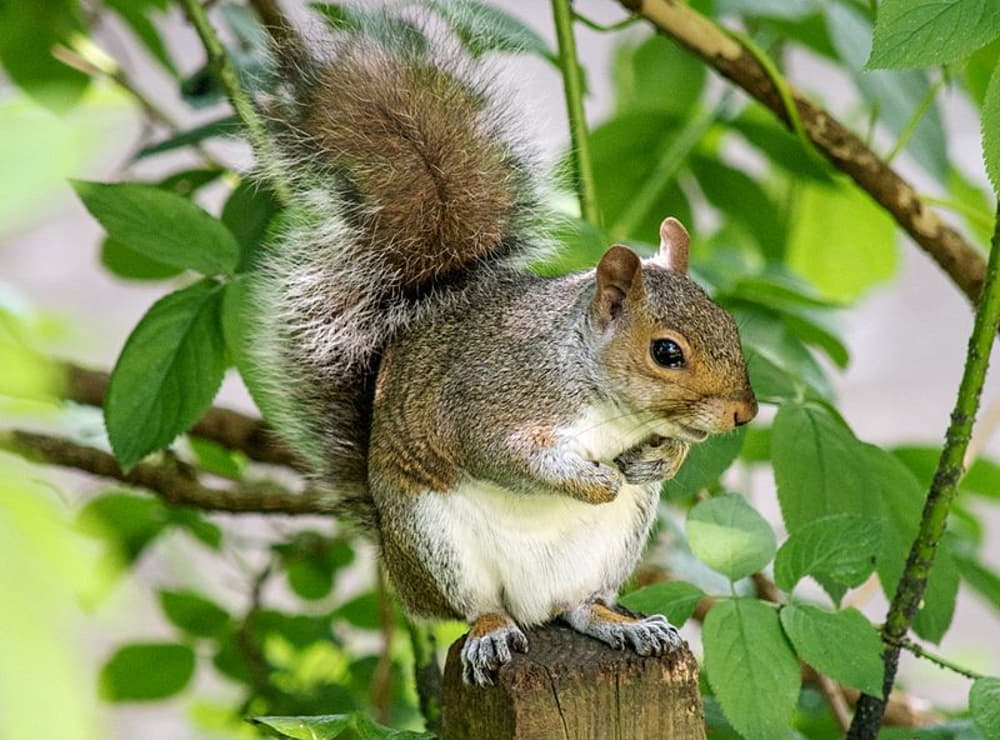Understanding how to find squirrels in the woods improves your experience and chances of success on your hunting trip. Squirrels are adept at blending into their surroundings, making this quest both exciting and challenging.
The world of squirrels is incredibly diverse, with over 200 species distributed across the globe. Each squirrel species has unique characteristics and habitat preferences. Observing their behavior, recognizing signs such as chewed nuts or distinctive nests, and listening for their distinct chattering are essential skills for hunters. From the subtle rustling of leaves to the telltale signs of gnawed nuts, there can be signs of a squirrel’s presence.
Most states allow hunters to lawfully chase squirrels for several months or more each year, with a daily harvest of four to six squirrels (mixed species). You need to understand the preferences and habitat of these creatures to increase your success rate when searching for them in the forest.
Table of Contents
The Squirrel’s Habitat
Habitat plays a crucial role in finding squirrels. Different species thrive in various environments, from deciduous and coniferous forests to mixed woodlands and even urban parks. Below is the habitat of 4 common squirrel species you often encounter.
Eastern Gray Squirrel
Eastern gray squirrels prefer mature hardwood forests with a mix of oak, hickory, and beech trees. They also thrive in urban parks and suburban areas with large trees and ample food sources. These squirrels build their nests, called dreys, in the forks of tree branches or in tree cavities.
Gray squirrels are known for their unique gray coats and can be found in deciduous woods and woodlands throughout eastern North America. They are also widely encountered in cities, making them one of the most identifiable and adaptable squirrel species.

Eastern gray squirrels are most active during the day and are known for their impressive climbing abilities. They spend a significant amount of time foraging for food, which includes nuts, seeds, fruits, and insects. These squirrels are usually storing food in various locations to prepare for the winter months.
Fox Squirrel
The fox squirrel is one of the largest squirrel species in North America, with a distinctive reddish-brown fur and a long bushy tail. They are commonly found in mixed woodlands and suburban areas, where they foraging.
Fox squirrels prefer mixed woodlands with a variety of tree species, including oaks, hickories, and pines. They are also commonly found in suburban areas with large trees and open spaces. These squirrels build their nests in tree cavities or in leafy dreys.
Similar to eastern gray squirrels, fox squirrels are diurnal and spend a significant amount of time foraging for food. Unlike other squirrel species, fox squirrels are ground-dwelling and can often be seen digging for buried food.
Red Squirrel
The red squirrel is a smaller species of squirrel, with a reddish-brown fur and a distinctive white belly. You can find this squirrel in coniferous forests, where they spend most of their time foraging for food and defending their territory.
Red squirrels prefer coniferous forests with a mix of pine, spruce, and fir trees. They are also commonly found in urban parks and suburban areas with large coniferous trees. These squirrels build their nests in tree cavities or in leafy dreys. Red squirrels are diurnal and highly territorial. This squirrel has a very loud voice and an aggressive nature even towards other squirrels.
Flying Squirrel
The flying squirrel is a unique species of squirrel that can glide through the air using flaps of skin between their front and back legs. Flying squirrels prefer wooded areas with a mix of deciduous and coniferous trees. They are also widely found in urban parks and suburban areas with large trees. These squirrels build their communal nests in tree cavities.
Unlike other squirrel species, flying squirrels are nocturnal and are most active at night. These squirrels are also noted for their gliding ability, which they utilize to navigate between trees.
How To Find Squirrels In The Woods
Embarking on a woodland quest to find squirrels, you should focus on early mornings or late afternoons when squirrels are most active. However, for flying squirrels, night is the ideal time to hunt them. Start by scanning the treetops and dense foliage, where they often engage in acrobatic displays. Squirrels are arboreal beings, adept at navigating trees with ease, so look for movement among branches.
You need to listen carefully for the distinctive murmuring and rustling sounds that accompany their activities. Squirrels communicate through vocalizations, alerting each other to potential dangers or signaling the availability of food. A sudden burst of chattering may indicate the presence of a nearby squirrel. Listen especially for vocalizations if you are hunting red squirrels as they are highly vocal.

Regarding habitat as mentioned above, gray squirrels often live in hardwood forests with many oak trees or urban parks. Fox squirrels prefer mixed forests with many different tree species. Red squirrels prefer coniferous forests and flying squirrels roost in wooded areas with a mix of deciduous and coniferous trees.
Besides, looking for signs of squirrels’ foraging behavior on the ground is also an effective way to find them. Squirrels are prolific gatherers and hoarders, often burying nuts for later consumption. You should look for scattered nutshells, gnawed pinecones, or small holes in the ground where they might have hidden their treasures.
You also can watch for nests, known as dreys, typically constructed high in the branches. Squirrels build nests from twigs, leaves, and other materials, creating cozy shelters for resting and raising their young. Spotting dreys can be a key indicator of a squirrel-inhabited area. Utilize patience and stillness to your advantage. Squirrels are generally wary of potential threats, and a quiet observer is more likely to witness their natural behaviors.
Read this post: How to Preserve a Squirrel Tail: The Easy Steps to Follow
Techniques For Finding Squirrels
There are 4 useful techniques for finding squirrels that we would like to recommend to you including: Use your senses, look for food sources, use binoculars or a camera and be patient and observant.
Use Your Senses
One of the best ways to find squirrels in the woods is to use your senses. Listen for the sound of rustling leaves and branches, as squirrels are often on the move. Look for signs of squirrel activity, such as chewed nuts, droppings, and gnaw marks on trees. You can also use your sense of smell to detect the scent of squirrel urine, which can be found near their nests.
Look For Food Sources
Squirrels are constantly on the lookout for food, so one of the best ways to find them is to look for their food sources. Keep an eye out for trees with nuts, seeds, and fruits, as these are common food sources for squirrels. You should look for signs of feeding, such as chewed nuts or empty shells.
Use Binoculars Or A Camera
Consider using binoculars or a camera with a telephoto lens, if you’re interested in observing squirrels from a distance. This can allow you to get a closer look at these creatures without disturbing them.
Be Patient And Observant
Finding squirrels in the woods requires patience and observation. Take your time and move slowly through the woods, scanning the trees and listening for any signs of squirrel activity. You need to observe and pay attention to your surroundings, as squirrels can often blend in with their environment.

